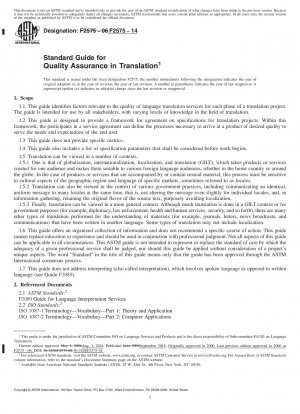ASTM F2575-14
Standard Guide for Quality Assurance in Translation
- Standard No.
- ASTM F2575-14
- Release Date
- 2014
- Published By
- American Society for Testing and Materials (ASTM)
- Status
- Replace By
- ASTM F2575-23
- Latest
- ASTM F2575-23e2
- Scope
4.1 Audience—This guide is intended to serve requesters and end users of translation, providers of such services, either internal or external, and training institutions, so as to facilitate clear communication, thereby avoiding potential losses in time, money, and quality during the life of a translation project.
4.2 Translation Supply Chain—The end user of a translation (the person who actually reads the target-language text) is often not the person who requests the translation. The requester, who can be an individual or hold nearly any position within an organization, may not know the target language or even the source language and thus may not be able to evaluate the translation personally. Likewise, the translation service provider contacted by the requester may not be the person who actually translates the document. Thus, it is important to have a standard guide for relationships between the requester and the translation service provider(s) so that certain questions are answered before starting a translation project—questions for which answers are critical to the successful delivery of a quality translation through the translation supply chain to the end user. That chain often includes the following parties: end user, requester, project manager, translator, editor, and any other additional personnel needed to complete the project (please see definitions in Section 3). In some cases, the same person may perform more than one function. For example, the end user and the requester can be the same person, and the project manager and the translator can be the same individual.
4.3 Importance of Specifications—Quality translation cannot be defined on the premise that there is only one correct, high-quality translation for any given source text. Certainly, there can be many different incorrect translations, but there can also be a variety of correct ones, depending on the specifications defined for a given project and the choices made by the individual translator. This guide includes a list of parameters (see Section 8) that need to be addressed and documented in writing to obtain a set of specifications that can be used to evaluate the quality of a particular translation. Specifications are defined in terms of the purpose of the translation and the needs and expectations of the end user. A set of specifications is not a metric, but could be used as the basis for defining a metric.
1.1 This guide identifies factors relevant to the quality of language translation services for each phase of a translation project. The guide is intended for use by all stakeholders, with varying levels of knowledge in the field of translation.
1.2 This guide is designed to provide a framework for agreement on specifications for translation projects. Within this framework, the participants in a service agreement can define the processes necessary to arrive at a product of desired quality to serve the needs and expectations of the end user.
1.3 This guide does not provide specific metrics.
1.4 This guide also includes a list of specification paramet......
ASTM F2575-14 Referenced Document
- ASTM F2089 Standard Practice for Language Interpreting*, 2024-04-20 Update
- ISO 1087-1 Terminology work - Vocabulary - Part 1: Theory and application
- ISO 1087-2 Terminology work - Vocabulary - Part 2: Computer applications
- ISO 9000:2005 Quality management systems - Fundamentals and vocabulary
ASTM F2575-14 history
- 2023 ASTM F2575-23e2 Standard Practice for Language Translation
- 2023 ASTM F2575-23e1 Standard Practice for Language Translation
- 2023 ASTM F2575-23 Standard Practice for Language Translation
- 2014 ASTM F2575-14 Standard Guide for Quality Assurance in Translation
- 2006 ASTM F2575-06 Standard Guide for Quality Assurance in Translation

Copyright ©2024 All Rights Reserved